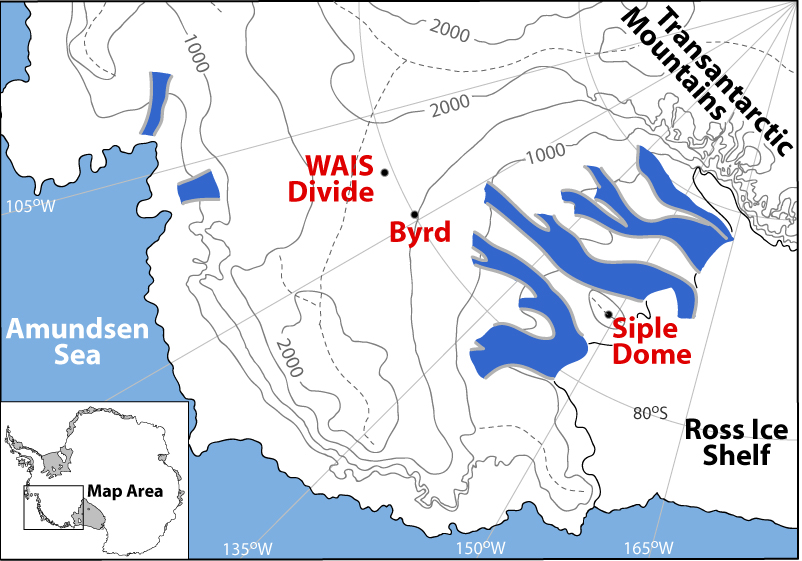WAIS Divide Ice Core
We are working on an NSF funded project to measure the depth profile of the cosmogenic radionuclide 10Be (half-life = 1.36 Myr) in a ~3400 m deep ice core from the West Antarctic Ice Sheet (WAIS) Divide, representing the last 68,000 years. The concentration of cosmogenic 10Be in polar ice is mainly a function of its production rate in the atmosphere, which in turn depends on modulation of the cosmic ray flux on Earth by changes in the solar magnetic field (also know as “solar activity”) and the geomagnetic field. Other factors that play a role are atmospheric mixing and transport processes that determine the distributions of 10Be over the Earth’s surface, the deposition mechanism of 10Be from the atmosphere to the snow surface, and the accumulation rate of snow which determines how much 10Be is diluted.
Since variations in the production of 10Be in the atmosphere occur on a global scale, the 10Be concentrations in ice cores can be used as chronological markers, e.g., to tie the records from Antarctic ice cores to those of Greenland ice cores or to tie the ice core record to the absolute tree ring 14C record. This last approach was used for the Holocene part of the WAIS Divide core (Sigl et al. 2016)

Synchronization of WAIS Divide timescale (WD2014) with independent IntCal13 tree-ring chronology (Figure 9 from Sigl et al. 2016) Results of the regression analysis between the WAIS Divide ice core 10Be data (this work) and tree-ring 10C records (Reimer et al. 2013). (Upper panel): Filtered 10Be (blue) and 14C (red) data on their respective timescales with green circles in the 10Be record marking 51 distinctive anomalies common with the p14C record used as timescale synchronization points. (Lower panel): Most likely time shift (red line) for the highly significant correlations together with the 2σ uncertainty range inferred from the r2 distribution (not shown). This is based on a regression analysis of windows of 2000 years length that are subsequently moved in steps of 100 years through the records. Green circles indicate the timescale difference for each visually derived synchronization point, with error bars indicating the age uncertainty for the respective Intcal13 14C data (Reimer et al., 2013). Results from the 10Be/14C comparison are superimposed on interpretation uncertainty envelopes from annual-layer counting (ALC) using relative uncertainties of 0.3 and 0.5%, respectively. The 10Be data provided important constraints in improving the preliminary WAIS-Divide timescale (WDC06A-7), which yielded consistently older ages than the currently accepted timescale (WD2014).
Publications from this project
Sigl, M, T. J. Fudge, M. Winstrup, J. Cole-Dai, D. Ferris, J. R. McConnell, K. C. Taylor, K. C. Welten, T. E. Woodruff, F. Adolphi, M. Bisiaux, E. J. Brook, C. Buizert, M. W. Caffee, N. Dunbar, R. Edwards, L. Geng, N. Iverson, B. Koffman, L. Layman, O. J. Maselli, K. McGwire, R. Muscheler, K. Nishiizumi, D. R. Pasteris, R. H. Rhodes, and T. A. Sowers (2016) The WAIS Divide deep ice core WD2014 chronology – Part 2: Annual-layer counting (0–31 ka BP). Climate of the Past 12, 769-786, 2016.
WAIS Divide Project Members. Precise interpolar phasing of abrupt climate change during the last ice age. Nature 520, 661-665, 2015, doi:10.1038/nature14401.
Sigl M., Winstrup M., McConnell J. R., Welten K. C., Plunkett G., Ludlow F., Büntgen U., Caffee M., Chellman N., Dahl-Jensen D., Fischer H., Kipfstuhl S., Kostick C., Maselli O. J., Mekhaldi F., Mulvaney R., Muscheler R., Pasteris D. R., Pilcher J. R., Salzer M., Schüpbach S., Steffensen J. P., Vinther B. M. and Woodruff T. E., Timing and climate forcing of volcanic eruptions for the past 2,500 years. Nature 523, 543-549, 2015, doi:10.1038/nature14565.
Mekhaldi F,. Muscheler R., Adolphi F., Aldahan A., Beer J., McConnell J. R., Possnert G., Sigl M., Svensson A., Synal H.-A., Welten K. C. and Woodruff T. E. Multiradionuclide evidence for the solar origin of the cosmic-ray events of AD 774/5 and 993/4. Nature Communications 6, 8611, 2015.
Woodruff T., Welten K. C., Caffee M. W. and Nishiizumi K., Interlaboratory comparison of 10Be concentrations in two ice cores from Central West Antarctica. Nuclear Instruments and Methods in Physics Research B294, 77-80, 2013.
Funding: NSF awards 0636964, 0839042, 1644128.
